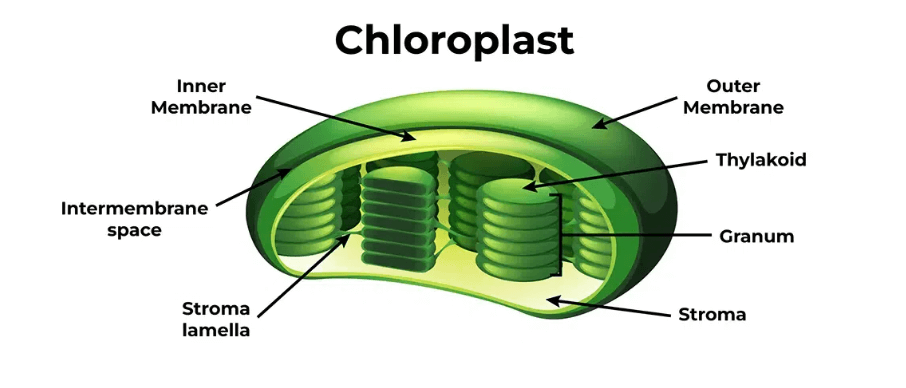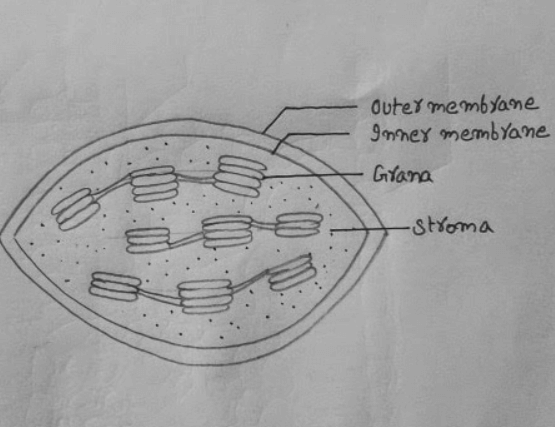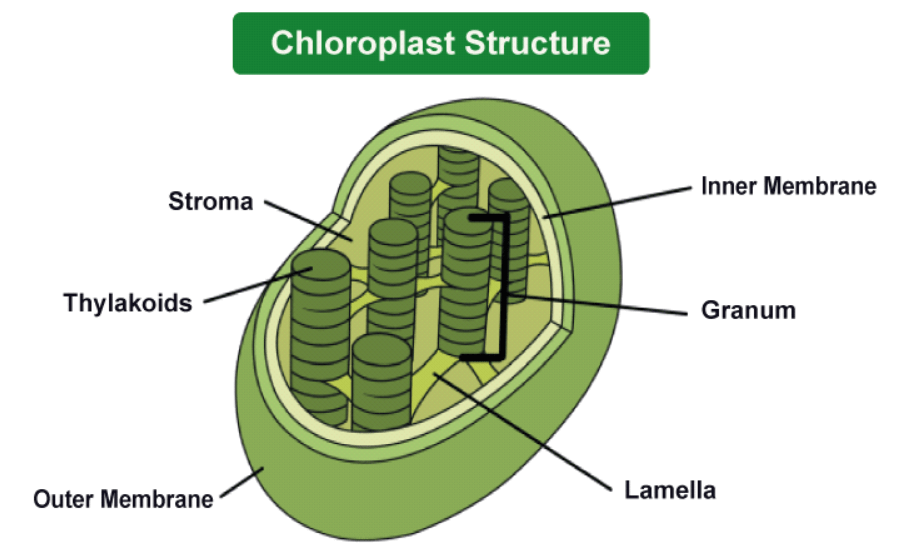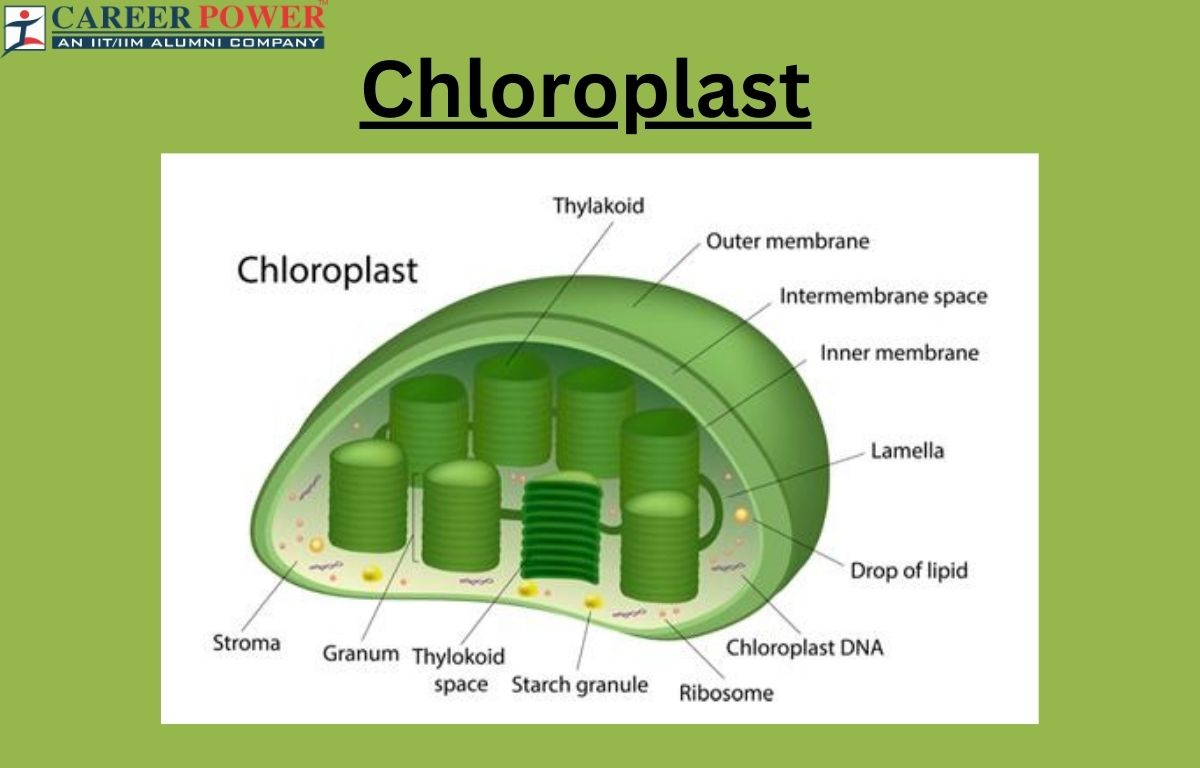Cell organelles are tiny structures inside cells that perform specific functions. Chloroplasts are a type of organelle found in plant cells. They are like little factories where photosynthesis occurs, a process that helps plants make food using sunlight, water, and carbon dioxide. Chloroplasts contain a pigment called chlorophyll, which gives plants their green color and plays a vital role in capturing light energy for photosynthesis. Here we have discussed a few more information related to the chloroplast, its structure, and functions below in the article.
Definition of the Chloroplast
Chloroplasts are double-membraned organelles found in plant and algal cells, responsible for photosynthesis and containing the green pigment chlorophyll. They convert light energy into chemical energy by capturing sunlight and using it to synthesize organic compounds, such as Glucose, from carbon dioxide and water. This process provides energy for the plant and oxygen as a byproduct. The Chloroplasts were discovered by a Swiss physician and botanist named Julius von Sachs in the 1860s. He conducted extensive research on plant physiology and was instrumental in the early understanding of photosynthesis and chloroplasts.

In addition to their role in photosynthesis, chloroplasts are unique organelles because they contain their own genetic material, similar to Mitochondria. This has led scientists to believe that they were once free-living bacteria that were engulfed by ancestral eukaryotic cells in a symbiotic relationship, eventually evolving into the present-day organelles. This endosymbiotic theory explains the presence of DNA in chloroplasts and mitochondria, as well as their ability to replicate independently within the host cells. Chloroplasts are essential for the survival of plants and are often referred to as the “Energy Factories” of plant cells due to their role in producing food and energy for the organisms.
Chloroplast: Diagram
The diagram of a chloroplast illustrates its structure and functions within plant cells. Chloroplasts are specialized organelles that perform photosynthesis, the process by which plants and other organisms convert light energy into chemical energy in the form of glucose. The diagram typically shows the chloroplast’s outer and inner membranes, thylakoid membranes, thylakoid membrane system, stroma, and pigments such as chlorophyll. Each component has a specific role in the process of photosynthesis, contributing to the plant’s ability to produce energy and oxygen from sunlight, water, and carbon dioxide.

Structure of the Chloroplast
Chloroplasts are specialized organelles found in plant cells and some other Eukaryotic organisms. They play a central role in Photosynthesis, the process by which plants convert sunlight, water, and carbon dioxide into glucose and oxygen. This structural organization allows chloroplasts to efficiently carry out photosynthesis, making them crucial for plants and other photosynthetic organisms. The structure of a chloroplast can be described as follows:
| Different structures of a Chloroplast | |
| Chloroplast Structure | Description |
| Double Membrane | The double membrane is the outer membrane that separates chloroplast from cell cytoplasm; the inner membrane encloses the stroma. |
| Thylakoid Membrane System | The Thylakoid Membrane system consists of flattened sacs called thylakoids, organized into stacks (grana); containing chlorophyll pigments. |
| Stroma | Stroma is the semi-fluid substance inside the inner membrane; containing enzymes for photosynthesis reactions. |
| Chlorophyll | Chlorophyll is the pigment molecules embedded in thylakoid membranes; that capture light energy for photosynthesis. |
| DNA and Ribosomes | DNA and ribosomes are chloroplasts that contain their own genetic material (DNA) and ribosomes for protein synthesis. |

Double Membrane
Chloroplasts are surrounded by a double membrane. The outer membrane separates the chloroplast from the cytoplasm of the cell, while the inner membrane encloses the stroma, a semi-fluid substance where various enzymes and molecules required for photosynthesis are found.
Thylakoid Membrane System
Inside the chloroplast, the inner membrane encloses a series of flattened sacs called thylakoids. These thylakoids are organized into stacks called grana. The thylakoid membranes contain pigments like chlorophyll, which are essential for capturing light energy during photosynthesis.
Stroma
The space inside the inner membrane, surrounding the thylakoid membranes, is called the stroma. The stroma contains enzymes necessary for the synthesis of carbohydrates during the process of photosynthesis.
Chlorophyll
Chlorophyll molecules are embedded in the thylakoid membranes and are responsible for capturing light energy. This energy is used to power the chemical reactions that convert carbon dioxide and water into glucose and oxygen.
DNA and Ribosomes
Chloroplasts contain their own genetic material in the form of DNA and have their own ribosomes, allowing them to produce some of their proteins independently.
Functions of the Chloroplast
Chloroplasts are specialized organelles found in plant cells and some other organisms like algae. They play a crucial role in the process of photosynthesis, which is how plants and algae convert light energy into chemical energy in the form of glucose. Chloroplasts are vital organelles that enable plants and algae to capture and utilize light energy, producing oxygen and glucose, which are fundamental for the survival of many organisms in the ecosystem. Here are the main functions of chloroplasts:
- Photosynthesis: Chloroplasts contain chlorophyll, a green pigment that captures light energy. During photosynthesis, chloroplasts use this energy to convert carbon dioxide and water into glucose and oxygen.
- Production of Glucose: The primary function of photosynthesis is to produce glucose, which is a form of stored energy that plants use for growth and metabolism.
- Oxygen Production: As a byproduct of photosynthesis, chloroplasts release oxygen into the atmosphere, which is essential for the survival of most organisms on Earth.
- Storage of Starch: Chloroplasts can store excess glucose in the form of starch. Starch serves as a long-term energy storage molecule for plants.
- Synthesis of Amino Acids and Lipids: Chloroplasts are involved in the synthesis of certain amino acids and lipids that are essential for the plant’s structure and function.
- Pigment Synthesis: Apart from chlorophyll, chloroplasts also produce other pigments that give plants various colors. These pigments have functions in light absorption and protection against excessive light.
- Regulation of Redox Reactions: Chloroplasts are involved in redox (reduction-oxidation) reactions, which are essential for energy transfer and various metabolic processes in the cell.



 50 Vegetables Name for Kids in English a...
50 Vegetables Name for Kids in English a...
 Food Chain: Definition, Types, Examples,...
Food Chain: Definition, Types, Examples,...
 Human Respiratory System: Definition, Di...
Human Respiratory System: Definition, Di...













